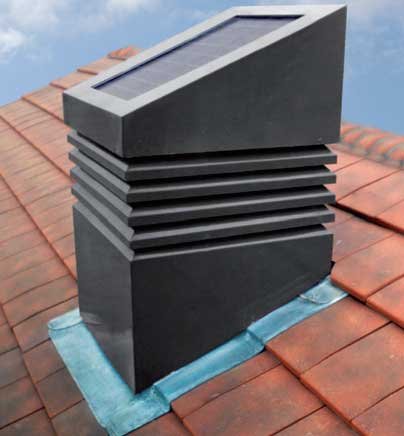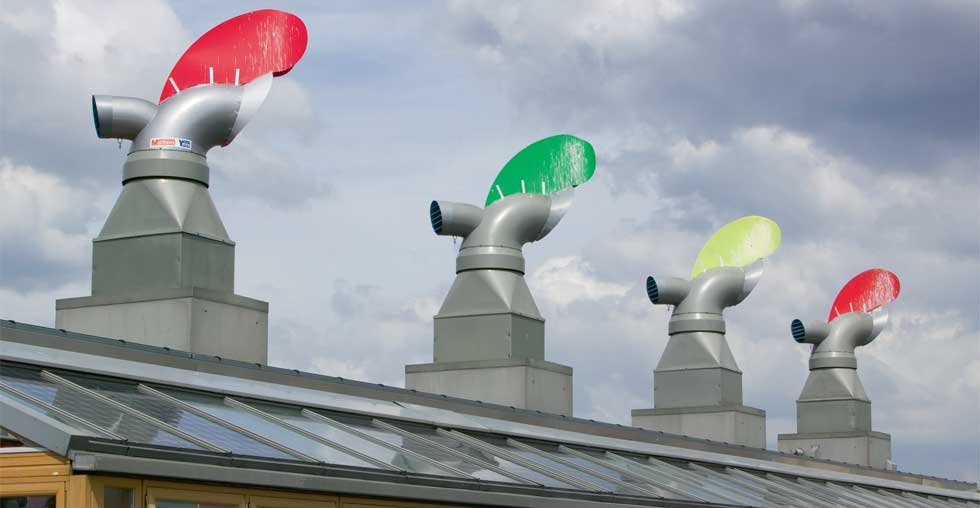on equivalently hi-tech,take a step back in time and discover how naturally free resources and good house design principles can offer the best supply of fresh air.
Before Building Regulations called for increasingly airtight houses and mechanical ventilation became the norm, people kept cool, fresh air in the house using natural methods: walls that ‘breathe’, breezes through windows, and large solid masses absorbing heat. These ideas were developed over thousands of years and became standard, integral parts of building design. Today they are called ‘passive ventilation’ and, ironically, are considered alternative technology to the ‘normal’ mechanical systems.
There are two basic types of passive ventilation: ‘pressure’ and ‘buoyancy’ systems.
Pressure Systems
Pressure systems rely on positive pressure on the windward side of the building causing a lower pressure on the leeward side, in turn creating air movement through the building from the windward to the leeward side. There are design implications in that vents, windows and room layouts have to be positioned appropriately to ensure air movement is possible and in the right direction.
Buoyancy ‘Whole-House’ Systems
Whole-house passive stack ventilation – or PSV – systems work on the buoyancy principal. Hot air is buoyant in cooler air and tends to rise. This is called the ‘stack effect’, which also describes the equipment. Put simply, an open fire with a chimney stack is a passive ventilation system. The chimney air is heated by the fire and the smoke carried away on the warm, rising air. In the same way, a PSV system will draw warm, moist air through ducts from a bathroom or kitchen and out through the roof. Fresh air can be introduced through vents in walls or windows in habitable rooms or ducted in from the roof.
In some cases, such as with Monodraught’s Windcatcher, both extracted air and fresh air use a single roof vent — stale air coming out of the leeward side of the stack and fresh air introduced on the windward side. The BedZED development famously uses the Arup PSV system where a specially designed cowl and ducting system allows the fresh air being introduced to be warmed by the air being extracted — effectively passive heat recovery. Refinements have been added to the standard PSV system to provide greater control. Systems are available that use humidity-controlled extract and inlet valves which open and close according to internal conditions, so that air is only extracted from the bathroom when the bath or shower have been used. Monodraught offers a system with a solar-powered fan (SEE BELOW).
New System
 Monodraught has launched a PSV system for homes with a solarpowered fan, providing the added benefit of more precisely controlling the volume of air being extracted, but without the need for extra energy.
Monodraught has launched a PSV system for homes with a solarpowered fan, providing the added benefit of more precisely controlling the volume of air being extracted, but without the need for extra energy.Ventilating Windows
An alternative way to warm the incoming air and thereby minimise the heat loss inherent in ventilation systems is to use ‘supply-air windows’. These are double-glazed windows with a third pane of glass on the outside with an inlet at the bottom of the third pane and an outlet at the top of the double-glazed unit — so that incoming air passes behind the third pane, gaining a little solar heat, and a little of the heat leaving the house through the double glazing, and enters the house a bit warmer. Dwell-Vent (dwell-vent.com) offers supply-air window PSV systems with non-return valves on the air vents to prevent warm air leaving the house.
Design Right
With the drive to achieve zero-carbon homes, building ever more airtight houses is becoming critical, and with it the need for controlled ventilation. A well-designed system will extract air from the right places and introduce the right amount of fresh air. Get the design wrong and you have either a damp, stuffy house or one that is cold and draughty.


Comments
Post a Comment